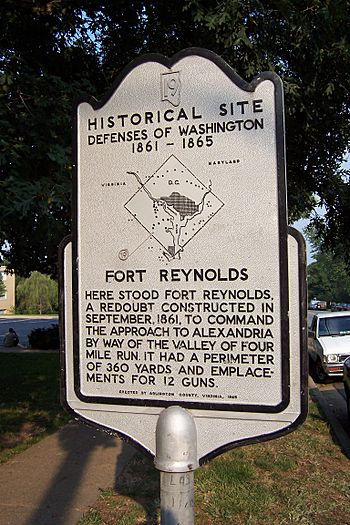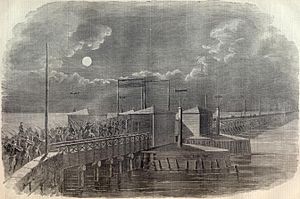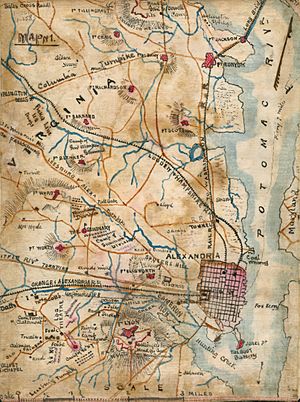Fort Reynolds (Virginia) facts for kids
Quick facts for kids Fort Reynolds |
|
|---|---|
| Part of the Civil War defenses of Washington, D.C. | |
| Arlington, Virginia, USA | |

Fort Reynolds historical marker
|
|
| Coordinates | 38°50′15″N 77°05′41″W / 38.8376°N 77.0948°W |
| Type | Earthwork fort |
| Site information | |
| Controlled by | Union Army |
| Condition | Stabilized |
| Site history | |
| Built | 1861 |
| Built by | U.S. Army Corps of Engineers |
| In use | 1861–1865 |
| Materials | Earth, timber |
| Demolished | 1865 |
| Battles/wars | American Civil War |
Fort Reynolds was a special kind of fort called a redoubt built by the Union Army during the American Civil War. It was part of a big plan to protect Washington, D.C. from attacks.
This fort was located in Fairlington, Arlington County, Virginia. It was built in September 1861. Its main job was to guard the way to Alexandria through the Four Mile Run valley. Another nearby fort, Battery Garesche, helped protect Fort Reynolds. The fort was about 360 yards (329 meters) around and had spots for 12 guns.
The fort was first named Fort Blenker after Colonel Louis Blenker, whose soldiers were stationed nearby. In late 1863, the fort was renamed. It honored Major General John F. Reynolds, a Union leader who died on July 1 at the Battle of Gettysburg in Pennsylvania.
Why Arlington Was Occupied
Before the Civil War began, Arlington County in Virginia was mostly farmland. It was the closest county to Washington, D.C. In 1847, this land became part of Virginia again after being part of D.C. for a while. Most people in the county lived in the city of Alexandria. The rest of the county had farms, houses, and the famous Arlington House. This house belonged to Mary Anna Custis Lee, who was married to Robert E. Lee.
After Fort Sumter was attacked in April 1861, President Abraham Lincoln said there was a rebellion. He asked for 75,000 soldiers to stop it. This made many Southern states angry, and they started talking about leaving the Union. Virginia decided to vote on whether to secede (leave the Union). The U.S. Army then created the Department of Washington. This group brought all Union soldiers in D.C. and Maryland under one command.
Brigadier General Joseph K. Mansfield, who led the Department of Washington, believed that Northern Virginia should be taken over quickly. He worried that the Confederate Army might put cannons on the hills in Arlington. From there, they could shoot at government buildings in Washington. He also wanted forts built on the Virginia side of the Potomac River. These forts would protect the ends of the Chain Bridge, Long Bridge, and Aqueduct Bridge. His leaders agreed but decided to wait until Virginia voted on secession.
On May 23, 1861, Virginia voted to leave the Union. That night, U.S. Army troops started crossing the bridges from Washington, D.C., into Virginia. The march began at 10 p.m. It was a very impressive sight.
Thousands of soldiers, including infantry, cavalry, and artillery, moved across the Long Bridge. Other troops crossed the Chain Bridge. They quickly took control of the high ground in Virginia.
Taking over Northern Virginia was mostly peaceful. The only problem was in Alexandria. There, Colonel Elmer E. Ellsworth went into a hotel to take down a Confederate flag. The hotel owner, James Jackson, shot and killed him. Ellsworth was one of the first soldiers to die in the Civil War. Because of this, Alexandria remained under Union control for the rest of the war.
Building Defenses After Bull Run
For seven weeks after Virginia was occupied, forts were built along the Potomac River. They also guarded the three main bridges connecting Virginia to Washington and Georgetown.
While these river forts were being built, plans were made for a huge new ring of forts. These new forts would protect Washington D.C. from all directions, not just the direct route through Arlington. But in mid-July, this work stopped because of the First Battle of Bull Run. Soldiers who were building forts instead marched to battle. After the Union Army lost at Bull Run, everyone panicked. They quickly built temporary trenches and earthworks to defend Washington from a possible Confederate attack. These defenses were mostly in Arlington and near the direct routes to Washington.
On July 26, 1861, five days after the battle, Maj. Gen. George B. McClellan became the commander of the military district of Washington. He later led the Army of the Potomac. When McClellan arrived in Washington, he was shocked by how weak the city's defenses were.
He said that the city's defenses were not strong enough to stop a serious attack. There were no defensive works on the Maryland side of the river. The enemy could easily shell the city from nearby hills.
To fix this, one of McClellan's first orders was to greatly expand Washington's defenses. Forts and trenches would be built in every direction. They would be strong enough to stop any attack. Alexandria, which had a large port, was a special concern.
Planning and Building Fort Reynolds
General John Newton was in charge of building the forts south of Four Mile Run. He oversaw the construction and made sure men and materials were available.
Fort Blenker (which later became Fort Reynolds) was built by the soldiers of General Louis Blenker. It was located north of Fort Ward, across what is now Route 7.
On January 17, 1862, Colonel J. Howard Kitching and his soldiers, the 6th New York Artillery, marched to the fort to finish building it. They had to quickly take down their old winter quarters and move to Fort Blenker to relieve other troops.
The fort had a perimeter of 360 yards and places for 12 cannons.
In 1954, Fort Reynolds was taken down to build an apartment complex. However, its name lives on with the nearby Fort Reynolds Park and a historical marker that tells its story.




